
The No. 8 Hose Station is a small fire hall that is a Toronto landmark. It is located on College Street at Bellevue and marks the northern end of Kensington Market and serves the Chinatown area at Spadina and Dundas.

The No. 8 Hose Station is a small fire hall that is a Toronto landmark. It is located on College Street at Bellevue and marks the northern end of Kensington Market and serves the Chinatown area at Spadina and Dundas.
The hall was built in 1878 as part of the transformation of the Toronto Fire Department that saw it move from a volunteer to a professional organization. The station was home to horse drawn hose car. The clock tower, that quickly became a symbol of the neighbourhood, was added in 1899. From the top of the tower a lookout would watch for fires. It was also useful for hanging hoses to dry. In 1911 it received the city's first motorized fire engine.
In the 1960s most of the old fire houses were demolished, but community pressure saved No. 8. However, in 1972 the building was gutted by fire. Again the community assured its survival and the building was rebuilt almost exactly as it had been before. The addition that stored the aerial ladder was replaced with the modern 3 bay addition that now houses the station's trucks. The original fire hall building is now used as a gym for Toronto Fire station 315.
The fire that gutted the hall in 1972 started when the crew was out fighting another fire
Coordinates: 43°39′24″N79°24′17″W / 43.656747°N 79.404797°W
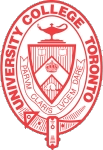
University College, popularly referred to as UC, is a constituent college of the University of Toronto, created in 1853 specifically as an institution of higher learning free of religious affiliation. It was the founding member of the university's modern collegiate system, and its non-denominationalism contrasted with contemporary colleges at the time, such as Trinity College and St. Michael's College, both of which later became part of the University of Toronto.

St. Lawrence is a neighbourhood located in downtown Toronto, Ontario, Canada. The area, a former industrial area, is bounded by Yonge, Front, and Parliament Streets, and the Canadian National railway embankment. The Esplanade off Yonge St., lined with restaurants, cafés and hotels runs through the middle of the area. In previous times, the area was sometimes referred to as 'St. Lawrence Ward' or more often today as 'St. Lawrence Market', synonymous with the large retail vendor market which is the neighbourhood's focal point. The area is the site of a large city-sponsored housing project of the 1970s, which revitalized an old brownfields area. The boundaries of the St Lawrence Neighbourhood Association and the St Lawrence Market BIA are somewhat larger than those noted above. Both groups have boundaries that extend from Yonge to Parliament Streets and Queen Street East to the rail corridor.

Exhibition Place is a publicly owned mixed-use district in Toronto, Ontario, Canada, located by the shoreline of Lake Ontario, just west of downtown. The 197-acre (80 ha) site includes exhibit, trade, and banquet centres, theatre and music buildings, monuments, parkland, sports facilities, and a number of civic, provincial, and national historic sites. The district's facilities are used year-round for exhibitions, trade shows, public and private functions, and sporting events.
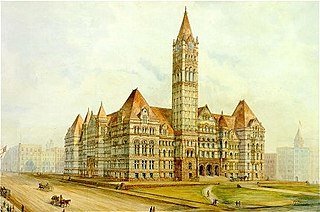
The Great Fire of Toronto of 1904 destroyed a large section of Downtown Toronto, Ontario, Canada on April 19, 1904. It was the second such fire for the city in its history.
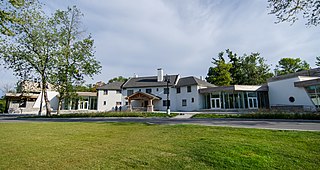
Guildwood, also known as Guildwood Village, is a residential neighbourhood in Toronto, Ontario, Canada. It is located in the eastern area of the city, in the district of Scarborough. It is bounded by the Scarborough Bluffs, south of Kingston Road, from Grey Abbey Trail in the east.
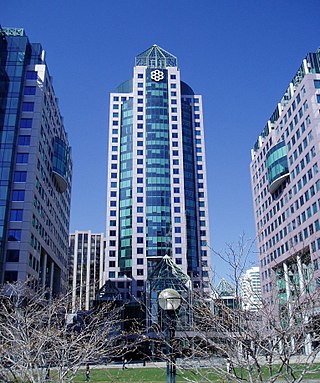
Metro Hall is a 27-storey Postmodern-style office tower at the corner of Wellington and John Street in the downtown core of Toronto, Ontario, Canada. It looks out onto Pecaut Square. Part of the three-tower Metro Centre complex, the building was completed in 1992 to house the Municipality of Metropolitan Toronto (Metro) and its employees. The building is now used by the City of Toronto following municipal consolidation in 1998.

The East York Civic Centre was the municipal office of the former borough of East York, now part of Toronto, Ontario, Canada as the result of municipal amalgamation. The two-storey civic buildings, located on the western side of Coxwell Avenue, were completed in 1990. Prior to 1990 it was the site of the East York Municipal Offices built in 1948, additions added in 1963 and 1975. The Township of East York Municipal Building was located nearby at 443 Sammon Avenue.
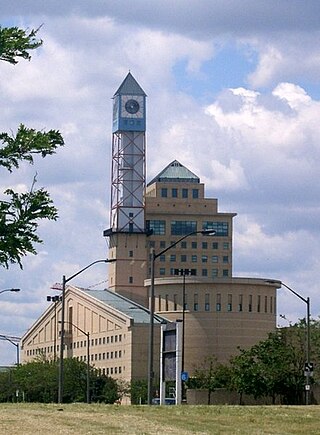
The Mississauga Civic Centre is the seat of local government of Mississauga, Ontario, Canada. The 37,280 square metre complex is a prominent example of postmodern architecture in Canada, finished in 1987 by Jones and Kirkland. It stands at 92 metres or 302 feet. The design was influenced by farmsteads which once occupied much of Mississauga as well as historical features of city centres. The building, for instance, includes a prominent clock tower. It was chosen as the winner of a design competition that included 246 submissions. Mississauga Civic Centre is located in the City Centre near Square One Shopping Centre and is home to the Mississauga City Council. The civic center building is considered one of the most iconic and recognizable buildings and cultural icons of Mississauga city.
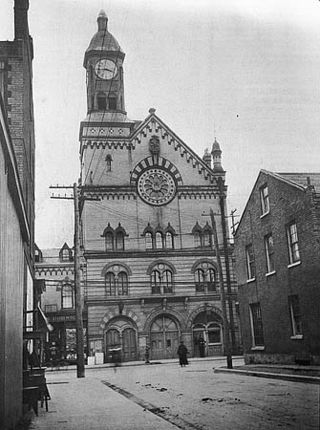
Yorkville Town Hall was the municipal building for the Village of Yorkville before its annexation by the City of Toronto. Built in 1859-1860 by architect William Hay and his apprentice Henry Langley, the three-storey building also served as an omnibus stop. The hall was located north of Bloor Street on Yonge Street, along the west side.

Downtown Toronto is the main central business district of Toronto, Ontario, Canada. Located entirely within the district of Old Toronto, it is approximately 16.6 square kilometres in area, bounded by Bloor Street to the northeast and Dupont Street to the northwest, Lake Ontario to the south, the Don Valley to the east, and Bathurst Street to the west. It is also the home of the municipal government of Toronto and the Government of Ontario.

The Markham Civic Centre is the city hall of the city of Markham, Ontario. The brick and glass Civic Centre was designed by architect Arthur Erickson with Richard Stevens Architects Limited and opened on May 25, 1990. Entrances, except the great hall entrance, are named after communities in Markham. The building is adjacent to an 11.5-hectare park with a large pond reflecting the south façade.

The Discovery District is one of the commercial districts in Downtown Toronto, Ontario, Canada. It has a high concentration of hospitals and research institutions, particularly those related to biotechnology. The district is roughly bounded by Bloor Street on the north, Bay Street on the east, Dundas Street on the south, and Spadina Avenue on the west.
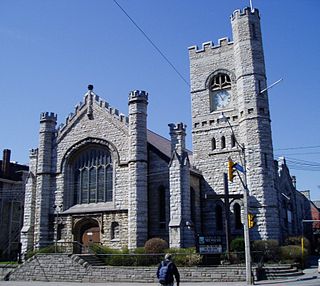
The Church of the Messiah is an Anglican church in Toronto, Ontario, Canada. It is located at 240 Avenue Road, on the corner of Dupont Street. The church was founded on March 24, 1891, by members of the Church of the Redeemer further south on Avenue Road. The building was designed by Gordon & Helliwell, along with a rectory next door.

Brampton City Hall is home to Brampton City Council and the departments of the city. It is located at the intersection of Wellington Street and Main Street in downtown Brampton.

The Alumnae Theatre, known most often as The Alum, is the oldest theatre society in Toronto, Ontario, Canada still in operation. It was founded in 1918 by female graduates of the University of Toronto who wanted to continue to participate in semi-professional theatre after graduation. Originally all performers in all roles were female, but in the 1920s the society began to invite male guest performers to join the performances. Still today the leadership of the society remains entirely female.

Main Square is a complex of four apartment buildings in Toronto, Canada. The three-hectare site houses about 2000 people. It is located in the eastern part of the city at the intersection of Main Street and Danforth Avenue. The complex is located just north of the railway lines and the Danforth GO Station and just south of the Main Street subway station. It consists of four towers, the tallest being 29 stories. At ground level, there is also a shopping plaza along Danforth and a city-run community centre.
St. Andrew's Playground is a small park in downtown Toronto. It is located at the 450 Adelaide Street West, at the northwest corner of Brant St and Adelaide. It has a playground for children and an off-leash area for dogs that is surrounded by a short fence, with an accessible water fountain for pets, children, and adults. A Heritage Toronto plaque in the northwest corner describing the history and significance of the park was installed in 2007.
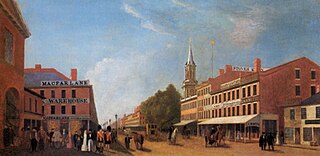
The Great Fire of Toronto of 1849, April 7, 1849, also known as the Cathedral Fire, was the first major fire in the history of Toronto, Ontario, Canada. Much of the Market Block, the business core of the city, was wiped out, including the predecessor of the current St. James Cathedral. The 1831 building of the Toronto City Hall and St. Lawrence Market south of King was damaged and was torn down.